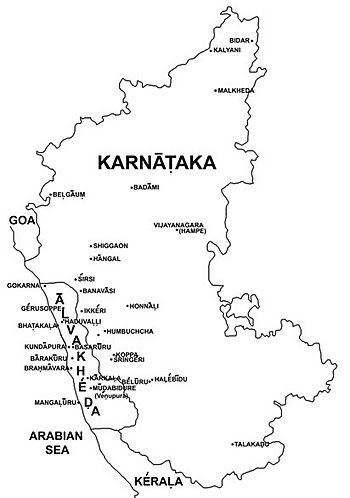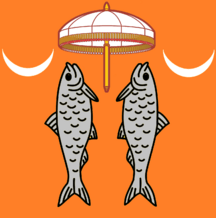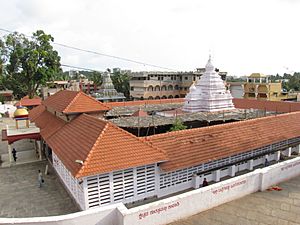Alupa dynasty facts for kids
Quick facts for kids
Alupa Dynasty
|
|||||||||
|---|---|---|---|---|---|---|---|---|---|
| 200–1444 | |||||||||

Extent of the Alupa Kingdom
|
|||||||||
| Capital | Mangalore, Udyavara, Barkur | ||||||||
| Common languages | Kannada Tulu | ||||||||
| Religion | Shaivism Vaishnavism Shaktism (Hindu Bunt, Jainism (Jain Bunt). | ||||||||
| Government | Monarchy | ||||||||
| King | |||||||||
| History | |||||||||
|
• Established
|
200 | ||||||||
|
• Disestablished
|
1444 | ||||||||
|
|||||||||
The Alupa dynasty was an ancient ruling family in India. They ruled for a very long time, from about the 2nd century CE to the 15th century CE. Their kingdom was called Alvakheda Arusasira. It covered the coastal areas of what is now Karnataka state in India, known as Tulu Nadu.
At first, the Alupas were independent rulers. But over time, stronger kingdoms like the Kadambas made them their allies or "feudatories." This meant they ruled their land but had to answer to a more powerful king. They later became allies of other big empires like the Chalukyas, Rashtrakutas, and Hoysalas. The Alupas ruled coastal Karnataka for an amazing 1200 years!
Interestingly, the Alupas followed a special rule for who became king next. It was called matrilineality (Aliyasantana). This meant the king's nephew (his sister's son) would take over, not his own son. For example, King Soyideva was followed by his nephew, Kulasekhara Bankideva. The people who are descendants of this dynasty today are often called Bunt. Many Bunt people still follow matrilineality. You can often tell them by their surnames like Shetty, Rai, Hegde, Alva, and Chowta. Most Bunt people are Hindu today, but many also follow Jainism. The last known Alupa king was Kulasekharadeva Alupendradeva, whose records are from 1444 CE.
Contents
What's in a Name? The Alupa Story
The name of this ruling family is written in different ways in old records, like Alupa, Aluva, Alva, Aluka, and Alapa. We don't know much about the Alupas before the Kadambas because there aren't many old writings from that time.
A geographer named Ptolemy from the 2nd century CE mentioned a place called Olokhoira. Many people think this name came from "Alva Kheda," which means 'the land of the Alvas.' In the Tulu language, ಆಳ್ಪು (Alup) means 'to rule.' So, the name Alupa might simply mean 'ruler.'
Some historians think the Alupas might have been connected to the Nāgas, who were ancient serpent people. This idea comes from a picture of a hooded serpent found on an old Alupa stone carving. Also, the Alupas were very devoted to the Hindu god Shiva, which was common among the Nāgas.
The Alupas were likely local rulers who first followed Shaivism (worship of Shiva). Later, around the 10th century, some of them became followers of Jainism. The title "Alupa" or "Alva" is still used by people in the Bunt community today.
The first clear mention of the Alupas is in the Halmidi inscription from 450 CE. It talks about an early ruler named Pashupathi. So, we can guess that the Alupa dynasty officially started around the 5th century CE. Their royal symbol was two fish. They also said they belonged to the Pandyavamsha and Soma Kula (meaning they were part of a lunar dynasty). Their coins even had the words "Sri Pandya Dhananjaya" on them, which means "Arjuna among the Pandyas."
The Land They Ruled
The Alupas mainly controlled the area that is now the Dakshina Kannada and Udupi districts. This region was known as Alvakheda in ancient times. Later, the area between the Swarna and Chandragiri rivers was called Tulunadu. People still use the name Tulunadu today.
Alvakheda: The Ancient Kingdom
The name Alvakheda appears in many old Alupa writings. This region included modern Tulunadu, parts of Udupi district, and even parts of Uttara Kannada district up to Ankola. It also stretched south into Kasaragod in Kerala. The term Alvakheda stopped being used in writings during the Vijayanagara period. At that time, Mangalore and Barkur became separate areas with their own governors.
Tulunadu: A Fertile Coast
This region goes from Mangalore in the south to the Swarna river in the north. To the west is the Arabian Sea, and to the east are the Western Ghats mountains. These mountains acted like a natural fort, protecting the land. Many rivers flowed through the area, especially near Mangalore and Udyavara, making the land very fertile.
The Western Ghats, thick forests, and coastal towns helped create many seaports. These ports were important for trade with the Romans as early as the 2nd century CE, and with the Arabs around the 7th century CE. The Netravati river in Mangalore and the Seethanadi river in Barkur were important rivers in the Alupa capital cities. Other rivers like Suvarnanadi, Shambhavi, Gurupura, and Nandini also flowed through the region.
The areas of Puttur, Sullia, Belthangady, and Karkala are hilly regions, important for farming. The coastal areas like Mangalore, Udupi, and Kundapur were known for sea activities, though farming was also done there. An old inscription from 1075 CE, found in Kerala, mentions King Kunda Alupa.
A Long History of Rule
The Alupa family became more well-known during the rise of the Badami Chalukya empire. Old writings show that the Alupas accepted the Chalukyas as their overlords. The Alupas ruled from different capital cities over time, including Mangalore, Udyavara in Udupi, and later Barkur. Their first complete inscription in Kannada language is from the early 7th century. They often formed marriage alliances with the powerful empires they were allied with.
The Alupas ruled parts of Udupi, Mangalore, Shimoga, Uttara Kannada, and northern Kerala. It's rare for any single dynasty in India to rule for over a thousand years, but the Alupas did! They started ruling the coastal region around the beginning of the Christian era, but became a recognized dynasty around the 5th century. The last ruler mentioned in their records is from the 14th century CE.
More than 200 stone inscriptions from this dynasty have been found. About 120 of them have been read and understood. The Belmannu copper plate from the 7th century CE shows some of the earliest and finest Kannada writing.
Alupa Coins
The Alupas started making their own coins in the 8th century CE and continued until the 14th century CE. Their coins had a special symbol: "Two fishes over a spread Lotus flower, below a royal umbrella." This was their family emblem.
They made coins called Pagodas and Fanams. On one side, the coins showed the "Two Fishes" symbol. On the other side, they had the words "Sri Pandya Dhanamjaya" written in either Nagari or old Kannada script. Kannada was the language used for their government.
The Alupas were one of only three dynasties that made gold coins as early as the 8th century CE. The gold came from trade with the Romans and Arabs, and from the nearby Gangas kingdom. The Alupas and Gangas made many different types of gold coins. These coins often had writing that helps historians figure out when they were made.
Temples and Art
The Alupas built many beautiful temples in their kingdom. Some of these include the Panchalingeshwara temple at Barkur, Brahmalingeshwara temple at Brahamavar, Koteshwara temple at Kotinatha, and the Sadashiva temple at Suratkal. They used building styles from the different powerful empires they were allied with over the centuries.
Sri Rajarajeshwari Temple, Polali

The Polali Rajarajeshwari Temple in Mangalore is one of the oldest temples with Alupa inscriptions. These inscriptions, written in Kannada, date back to the 8th century. The Alupa kings supported and improved this temple throughout their rule.
Sri Manjunatheshwara Temple, Kadri
The Kadri Manjunath temple in Mangalore is another important old temple from the Alupa period. It has several beautiful bronze statues that King Kundavarma had installed in 968 CE. One inscription on a statue even compares King Kundavarma to the brave hero Arjuna.
Sri Mahishamardini Temple, Neelavara
The Alupas sometimes moved their capital city between Mangalore, Udyavara, and Barkur, depending on what was happening politically. They even moved to Barkur to be more central to their large territory. When they were in Barkur, they supported many temples nearby. The Mahishasuramardini temple in Neelavara has several Alupa inscriptions from later times.
Sri Panchalingeshwara Temple, Vittla
This temple is one of the oldest in the Alupa region, built around the 7th century CE. Its architecture is similar to the Sri Ananteshwara temple, which is also very old. The Alupas invited Havyaka Brahmins to their kingdom in the 7th century CE and gave them land. These Brahmins helped teach Vedic knowledge to the people. The Alupas built many temples and let these Brahmins take care of them.
Sri Anantheshwara Temple, Udupi
The Sri Anantheswara Temple in Udupi is one of the oldest Alupa temples. It is believed that lighting a lamp here can remove bad luck and sins. It is a large temple in Udupi, with a main idol that looks like the face of Lord Shiva.
Both the Vittla Panchalingeshwara and Udupi Anantheshwara temples have a unique curved roof shape, like the back of an elephant. This style is also seen in the Aihole Durga temple from the 7th century CE. The roofs of temples in South Canara are special because they are designed for heavy rainfall, using materials like grass, clay tiles, and even copper plates.
Important Rulers
| Ruler's name | Year of reign | Notes |
|---|---|---|
| Pashupathi | 450 CE | Earliest known Alupa king |
| Aluvarasa I | Early 7th century | Father-in-law of Pulakeshin II |
| Chitravahana | 663–730 CE | Married to a Chalukya princess |
| Kundavarma | 960–980 CE | Installed bronze statues at Kadri temple |
| Pandya Pattiyodeya | 1080–1110 CE | |
| Pattiyodeya Kulashekara Alupendra | 1160–1220 CE | |
| Queen Ballamahadevi and Nagadevarasa |
1275–1285 CE | A ruling queen |
| Kulashekara | 1335–1346 CE | Son of Hoysala Veera Ballala III's daughter |
| Kulashekara III | 1355–1390 CE |




